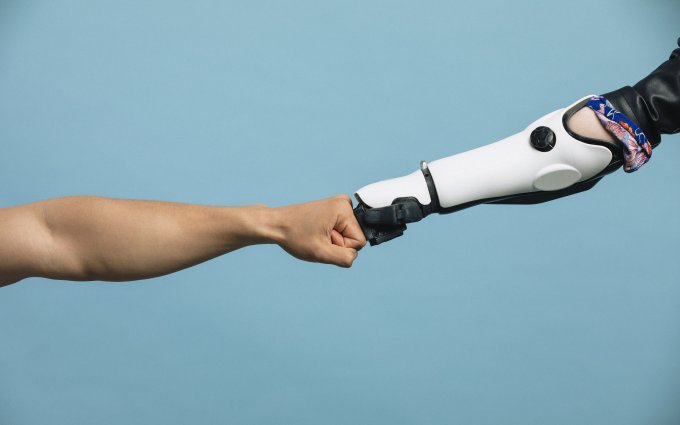In 1982, Hugh Herr injured both of his legs following a mountain climbing accident, and both of them had to be amputated. They were replaced with bionic limbs. But Hugh isn’t your ordinary mountain climber. He’s also the director of the MIT Media Lab’s Biomechatronics research group, and his interest in prosthetics is both professional and personal.
“At that time, I didn’t view my body as broken. I reasoned that a human being can never be broken. Technology is broken. Technology is inadequate,” Herr said. In his TED talk in 2014, he explained that “this simple but powerful idea was a call to arms to advance technology to the elimination of my own disability, and ultimately to the disability of others.”
Fast forward to today. After losing his arm to cancer, Johnny Matheny never thought that he would be able to use a prosthetic arm that could be controlled using electromyography technology. “The APL arm is the most unique arm I’ve ever worn,” Matheny said. “It has the ability to do anything that your natural hand, wrist, elbow, shoulder can do.”
Bridging the gap between disability and ability
Electromyography gesture-controlled prosthetics is just one of the latest advances in the field of prosthetic limbs. From neurotechnology to 3-D printing, prosthetics are improving by leaps and bounds. Here are just a few examples of the latest technology changing the lives of amputee patients.
- Electromyography: Electromyography is a technique that uses the electricity running through muscles as the patient moves them to control the limb. A specially designed armband picks up the EMG signals from the injured worker’s muscles, and sends them wirelessly to a nearby computer to be translated into commands for the limb and relayed back in real-time.
- Robotic limb: Recently, DARPA announced that they’ve created a robotic arm that gives an injured worker a sense of touch. The arm works via neural implants that are connected to a computer, which then signals the limb to tell it how to move with feedback from the device. These neurotechnological prosthetics, while currently cost-prohibitive, could become more mainstream in future years.
- Self-tuning prosthetics: Currently, powered prosthetic legs need to be tuned and re-tuned by experts, creating multiple office visits and higher costs. Now biomedical engineering researchers at North Carolina State University and UNC Chapel Hill are working on creating self-tuning prosthetics, which will help reduce prosthetist-related costs and make devices more functionally useful.
- 3-D Printing: Researchers at MIT are using computers and 3-D printers to make endpoints for prosthetics more efficient while also reducing discomfort. The gathered data records the surface’s shape as well as the tenderness of the area, ultimately customizing the prosthetic for each individual. Collaborators at MIT believe this technology may hold the key to creating next-generation prosthetic sockets.
- Bionic eyes: Last year it was reported that the world’s first bionic eyes were attached to the retinas of dozens of blind people, helping them to distinguish light from dark and recognize the outlines of objects. The findings suggest opportunities for future advancements in this field of prosthetics, but the current successes are promising.
Prosthetics help empower injured workers after an amputation by increasing their level of function for everyday tasks. With the help of a skilled team and a comprehensive prosthetics treatment plan, most amputees can achieve maximum functional restoration following a catastrophic injury. As innovations in the world of prosthetics develop, we’re excited to see what the future holds.
